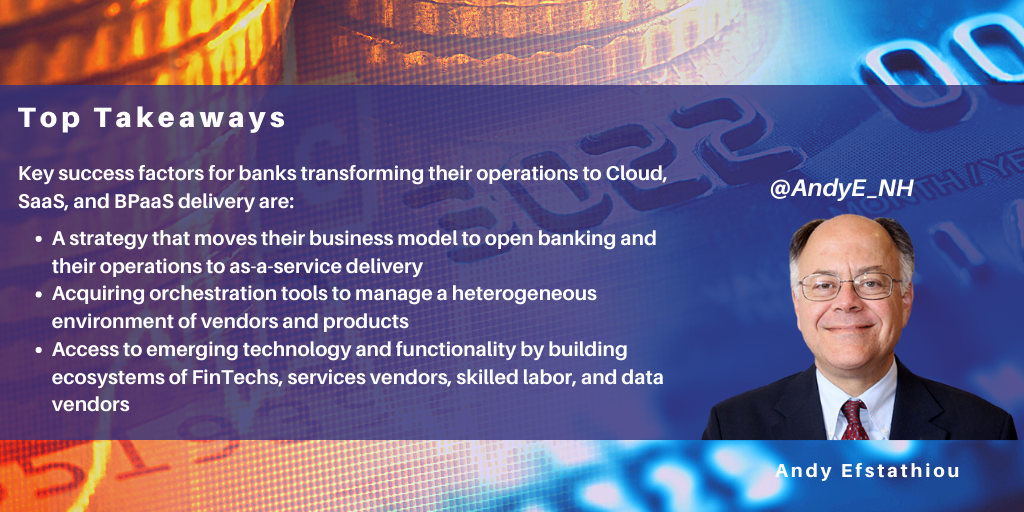posted on Apr 06, 2023 by Andy Efstathiou

NelsonHall recently completed a market assessment and forecast report on Transforming Financial Services with Cloud, SaaS, and BPaaS Services. It reveals that the financial services industry is responding to the industrialization of cloud services from hyperscalers and IT services vendors by transforming its platforms to microservices architectures and then moving them to the cloud. Data management across markets, businesses, and entities has moved to center stage to drive compliance and customer management.
The operational transformation challenge
Tier 1 banks are looking for increasing operational agility with migration to cloud and as-a-service delivery. Smaller banks require productized solutions and SaaS/BPaaS services. All banks are increasing their data management and AI purchases. In the future, banks will move towards SaaS and BPaaS to reduce labor costs and increase the configurability of their businesses. Operational delivery will become agile to support reducing time to market and accommodate volume fluctuations.
However, the external environment has put up barriers to transformation. The key barriers impeding banks’ transformation efforts include:
- Platform modernization: legacy mainframe platforms need to be redesigned into a microservices architecture. Finding teams that can work with both legacy and modern languages is difficult
- Data management and analysis: effective use of AI requires large databases from which to derive insights. Most bank portfolios are too small to generate large data sets for meaningful analysis
- Accessing emerging technologies: skilled labor remains in short supply and worker turnover has made it worse
- Creating a roadmap: new business models require experimentation and agility, which large banks find difficult to undertake effectively.
Financial institutions must adapt transformation strategies
To transform their businesses, financial institutions will have to:
- Create a strategy that moves operations to the cloud and matches costs to revenues to enable greater agility. They will have to change their business model to an open banking model
- Build an ecosystem of operational vendors including: hyperscalers, with each one providing services in their area of expertise; IT services vendors with knowledge of the client’s environment; and FinTechs with key functionality
- Redefine the split of operations between external processes (high value, cyclical or one-time) and internal processes (lower value/less volatile)
- Acquire orchestration tools to manage a heterogeneous environment of vendors and products
- Transform application development to a DevOps and low/no code model to speed the innovation cycle and enable LOB staff to have greater input.
Services vendors are supporting clients with different services for each environment:
- Cloud: support for entering new markets and enabling open banking
- SaaS: data management tools, analytic tools, and data and solution provider partnerships
- BPaaS: offerings focused by line of business which have high volatility (e.g., collections and securities)
- Platforms: provision of low code/no code DeFi coding capabilities, APIs to solution/data vendors and industry consortia, enhanced solutions with hyperscaler partnerships, and orchestration tools to manage hybrid multi-cloud environments.
Summary
In summary, high competition and regulatory change is driving banks to focus on changing their business models and product mix. The change to shorter product cycles and lower margins means banks changing their operational focus from cost efficiency for fundamentally static businesses to agility for continuously changing businesses. Cloud, SaaS, and BPaaS infrastructure will drive accelerating change in banks’ product offerings, customer base, and market presence. The financial industry is at the start of a long-term transformation of its business model.
Find out more about NelsonHall’s Transforming Financial Services with Cloud, SaaS, and BPaaS Services market assessment and forecast report here or contact Guy Saunders.
